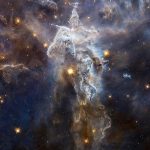Key Takeaways
- Olympus Mons, the largest volcano in the solar system, stands on Mars, towering above its surroundings.
- This shield volcano is about 16 miles high and 374 miles in diameter, making it significantly larger than Earth’s Mauna Loa.
- Its relatively young surface, scarce impact craters, and potential rock glaciers suggest ongoing volcanic activity.
- The volcano’s formation is influenced by Mars’ lower gravity, slow lava flow, and lack of tectonic plate movement.
- The extended lifetime of Olympus Mons is indicated by Martian meteorites, with eruptions spanning billions of years.
- The volcano’s exploration presents challenges, but ideas for virtual reality climbing routes and space tourism missions have been proposed.
Mars, the red planet, harbors an awe-inspiring marvel in its terrain – Olympus Mons, the solar system’s grandest volcano. Situated in the Tharsis Montes region near the Martian equator, this colossal shield volcano reaches a staggering 16 miles into the heavens and spans 374 miles in diameter, rivaling the entire state of Arizona. To put it in perspective, Olympus Mons dwarfs Earth’s Mauna Loa and Mount Everest, both in size and elevation.
This Martian titan is distinctively a shield volcano, characterized by its gradual slopes formed by the slow flow of lava. Contrary to the violent eruptions seen on Earth, Olympus Mons has built its immense structure over time, making it a geological marvel. Its relatively youthful surface, marked by a scarcity of impact craters, suggests the potential for ongoing volcanic activity, with the last eruption estimated to have occurred around 25 million years ago.
The formation of Olympus Mons is attributed to a combination of Mars’ unique features: lower gravity, slower lava flow, and limited tectonic plate movement. Unlike Earth’s constantly shifting crust, Mars’ lack of plate movement allowed for the steady accumulation of lava in one location. This contributed to the formation of the Tharsis Montes volcanic region, which includes several gigantic volcanoes akin to Olympus Mons.
Remarkably, researchers have probed the volcano’s history through Martian meteorites, revealing a remarkable tale of longevity. These meteorites indicate that the volcano’s eruptions span billions of years, much longer than their terrestrial counterparts. This longevity is attributed to Mars’ stable magma plume location, untouched by tectonic forces that reshape Earth’s surface.
While scaling Olympus Mons’ lofty heights remains a distant dream due to its challenging terrain, innovative proposals such as virtual reality climbing routes and even space tourism missions have been put forth. Although setting foot on its summit may elude us for now, technology and human curiosity allow us to visually explore this titanic wonder from afar, revealing the mysteries of the universe one crater at a time.
#1

Orbital view of Mars’ Olympus Mons volcano (Image credit: Getty Images)
#2

The black outline of Arizona over this image of Olympus Mons shows the similar surface areas. (Image credit: NASA)
#3

Lava is believed to have flowed from this large volcanic vent in the Tharsis region on Mars. (Image credit: NASA/JPL-Caltech/Univ. of Arizona)
#4

MOC image of Olympus Mons
#5

Author: ESA/DLR/FUBerlin/AndreaLuck
#6

Credit: Dora9922
#7

#8

Credit: NASA


